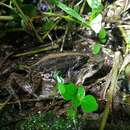pms
nòm ant ël fil


Minervarya syhadrensis, commonly known as long-legged cricket frog, Syhadra frog, Bombay wart frog, and many others, is a species of frog in the family Dicroglossidae found in India, Bangladesh, and Nepal at low to moderate elevations.[2] It is the type species of genus Minervarya.[2] In view of its wide distribution and stable population trend, IUCN assessors listed it as Least Concern in 2009 and 2016.[1]
The long-legged cricket frog is a small-sized frog. Females reach a snout–vent length (SVL) of 20.7–22.8 mm. Males are smaller with a SVL of 17.5–19.1 mm.[3]
Long-legged cricket frogs are widely distributed over much of central northern India and western Peninsular India, Bangladesh, southern Nepal, from lower Punjab to Sindh in Pakistan, and found at elevations below 2,000 metres (6,600 ft).[1] In Nepal's Shivapuri Nagarjun National Park, 13 specimen were observed in the summer of 2009 within a distance of 50 metres (160 ft) from water bodies.[4]
During the breeding season, males emit advertisement calls, using a single subgular external vocal sac. They start calling after one or two heavy pre-monsoon or monsoon rains in April to June, and continue up to the end of the rainy season in September to October. They call mainly during the night beginning after dusk and continue until the early morning of the following day, preferably sitting in temporary shallow water pools under partly submerged grass or paddy. They call in chorus but maintain a distance of 0.5 to 1 m to each other. Their calls are antiphonal between the two nearest calling males and consist of a series of pulse groups varying per call between 7 and 28.[3]
Minervarya syhadrensis, commonly known as long-legged cricket frog, Syhadra frog, Bombay wart frog, and many others, is a species of frog in the family Dicroglossidae found in India, Bangladesh, and Nepal at low to moderate elevations. It is the type species of genus Minervarya. In view of its wide distribution and stable population trend, IUCN assessors listed it as Least Concern in 2009 and 2016.
Fejervarya syhadrensis Fejervarya generoko animalia da. Anfibioen barruko Dicroglossidae familian sailkatuta dago, Anura ordenan.
Fejervarya syhadrensis Fejervarya generoko animalia da. Anfibioen barruko Dicroglossidae familian sailkatuta dago, Anura ordenan.
Zakerana syhadrensis est une espèce d'amphibiens de la famille des Dicroglossidae[1].
Cette espèce se rencontre en dessous de 2 000 m d'altitude[1] :
Sa présence est incertaine en Birmanie.
Zakerana syhadrensis[2] mesure jusqu'à 35 mm. Son dos est gris avec des taches noires, parfois rougeâtres, et souvent une fine ligne longitudinale pâle. Sa face ventrale est blanche. Les mâles ont la gorge noire.
Son nom d'espèce, composé de syhadr et du suffixe latin -ensis, « qui vit dans, qui habite », lui a été donné en référence au lieu de sa découverte, Syhadr.
Zakerana syhadrensis est une espèce d'amphibiens de la famille des Dicroglossidae.
Minervarya syhadrensis (Annandale, 1919) è un anfibio appartenente alla famiglia Dicroglossidae, diffuso nel sud-est asiatico.[1]
La colorazione di questa specie è composta da un colore grigiastro sul dorso, con macchie scure, con la presenza a volte di sfumature rossastre e arancioni; il ventre è bianco. In alcuni esemplari è presente una linea mediana chiara e stretta che parte dalla testa e attraversa tutto il corpo. Una curiosità particolare di questa specie è che durante la stagione riproduttiva, la regione golare maschile diventa nera.
M. syhadrensis è una rana di piccole dimensioni. Le femmine raggiungono una lunghezza del muso-ventre (SVL) di 20.7-22.8 mm. I maschi sono più piccoli con una lunghezza SVL di 17.5-19.1 mm.[2]
È una specie insettivora.
Durante la stagione riproduttiva, i maschi emettono richiami, usando un singolo sacco vocale esterno subgolare. Iniziano a chiamare dopo una o due forti piogge pre-monsoniche o monsoniche da aprile a giugno e continuano fino alla fine della stagione delle piogge tra settembre e ottobre. Chiamano principalmente durante la notte, iniziando dopo il crepuscolo e proseguendo fino alla prima mattina del giorno successivo, preferibilmente seduti in pozze temporanee d'acqua poco profonde, sotto l'erba parzialmente sommersa o in risaie. Anche se il loro richiamo viene emesso in coro, mantengono una distanza di 0.5-1 m l'uno dall'altro. I loro richiami sono antifonali tra i due maschi chiamanti più vicini e consistono in una serie di gruppi di impulsi che variano per ogni chiamata tra 7 e 28.[2]
Questa specie depone uova in piccoli lotti incorporate in materiale gelatinoso, ciascuna racchiusa in una doppia capsula gelatinosa e quando si separano aderiscono ai fili d'erba. Le dimensioni variano da 0.8 a 1.2 mm.
M. syhadrensis abita l'ecozona indomalese.[3]
Il suo habitat include le savane e praterie del Terai-Duar, le foreste spinose nord-occidentali, le foreste di latifoglie dell'Himalaya orientale, la pineta subtropicale dell'Himalaya e le foreste decidue umide dei Ghati Occidentali settentrionali.[3]
Questi territori si estendono nel sud-est asiatico e comprendono gli stati del Bangladesh, India centro-settentrionale e peninsulare occidentale (nei Ghati occidentali), Nepal, Pakistan (dal Punjab meridionale sino al Sindh) e Sri Lanka ad altitudini inferiori ai 2000 m.[1][4]
Nel parco nazionale di Shivapuri Nagarjun sono stati osservati 13 esemplari nell'estate del 2009 entro una distanza di 50 m da corpi idrici.[5]
La specie occupa un areale abbastanza vasto, all'interno del quale la popolazione si presume stabile. Per questo motivo la Lista rossa IUCN classifica Minervarya syhadrensis come specie a rischio minimo (Least Concern).[1]
Minervarya syhadrensis (Annandale, 1919) è un anfibio appartenente alla famiglia Dicroglossidae, diffuso nel sud-est asiatico.